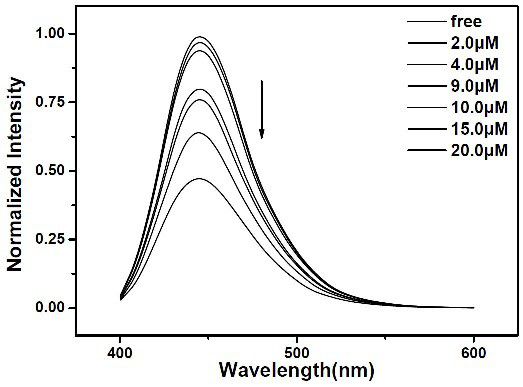A kind of mercury ion detection probe and its preparation method and application
A technology for detecting probes and mercury ions, which is applied in the field of chemical analysis and detection, can solve the problems of expensive instruments and troublesome sample processing, and achieve the effects of low detection limit, sensitive recognition and strong specificity
- Summary
- Abstract
- Description
- Claims
- Application Information
AI Technical Summary
Problems solved by technology
Method used
Image
Examples
Embodiment 1
[0042] Synthesis of fluorescent probes of the present invention
[0043] The preparation route of fluorescent probe of the present invention is as follows:
[0044]
[0045] (1) Preparation of intermediate compound 2
[0046] Dissolve compound 1 and o-aminothiophenol in dimethyl sulfoxide (DMSO), the ratio of the amount of compound 1 and o-aminothiophenol is 1:1, heat reaction at 60 degrees for 6 hours, TLC monitoring Reaction process, after the reaction is complete, the reactant is cooled to room temperature, added with water, then separated and extracted, dried, and then subjected to column chromatography to obtain compound 2;
[0047] (2) Preparation of fluorescent probe I
[0048] Dissolve compound 2 and barbituric acid in DMSO, the ratio of the amount of compound 1 to barbituric acid is 1:1, heat and stir at 70 degrees for 10 hours, filter and separate the solid product in the reaction solution, and then use Washing with absolute ethanol for 3 times, the compound I ...
Embodiment 2
[0051] Ratiometric Fluorescent Probe Molecular Working Curve
[0052] Take 2 mL of the prepared aqueous dispersion solution of ratiometric fluorescent probe molecules, add 20 μL of different concentrations (0, 1, 2, 3, 4, 5, 6, 7, 8, 9, 10, 15, 20, 50 μmol / L) Mercury iodide aqueous solution, after standing for 60 min, the fluorescence spectrometer records the change of fluorescence intensity at 455nm. Taking the fluorescence intensity as the ordinate and the copper ion concentration as the abscissa, the working curve of the ratio fluorescent probe molecule is obtained by fitting. In the present embodiment, the ratiometric fluorescent probe is used for measuring the concentration of copper ions. Under the excitation of 375nm excitation light, the relationship between the fluorescence intensity and the concentration of copper ions is as follows: figure 1 As shown, the fluorescence intensity value decreases with the increase of mercury ion concentration.
Embodiment 3
[0054] Fluorescent Probe Molecular Cation Selectivity Determination
[0055] Take 2mL of the water-dispersed solution of the ratio fluorescent probe molecule prepared in Example 2, add 20 μL of Li with a concentration of 0.01M + 、K + 、Na + 、Sr 2+ 、Ba 2+ , Mg 2+ , Ca 2+ , Zn 2+ 、Ni 2+ 、Co 2+ , Hg 2+ , Pb 2+ , Pd 2+ , Fe 2+ , Mn 2+ 、Al 3+ 、Cr 3 + 、Cd 2+ , Fe 3+ After the aqueous solution was left for 60 minutes, the fluorescence spectrometer recorded the change of the fluorescence intensity at 445nm. Experimental results show that, except for mercury ions, other ions do not cause obvious changes in the fluorescence at 445 nm, indicating that the probe molecules of the present invention have good selectivity. In this embodiment, the molecular selectivity of the fluorescent probe is measured, and the relationship diagram of the fluorescence intensity changing with different ions under the excitation of 375nm excitation light is as follows figure 2 shown.
PUM
 Login to View More
Login to View More Abstract
Description
Claims
Application Information
 Login to View More
Login to View More - R&D
- Intellectual Property
- Life Sciences
- Materials
- Tech Scout
- Unparalleled Data Quality
- Higher Quality Content
- 60% Fewer Hallucinations
Browse by: Latest US Patents, China's latest patents, Technical Efficacy Thesaurus, Application Domain, Technology Topic, Popular Technical Reports.
© 2025 PatSnap. All rights reserved.Legal|Privacy policy|Modern Slavery Act Transparency Statement|Sitemap|About US| Contact US: help@patsnap.com



